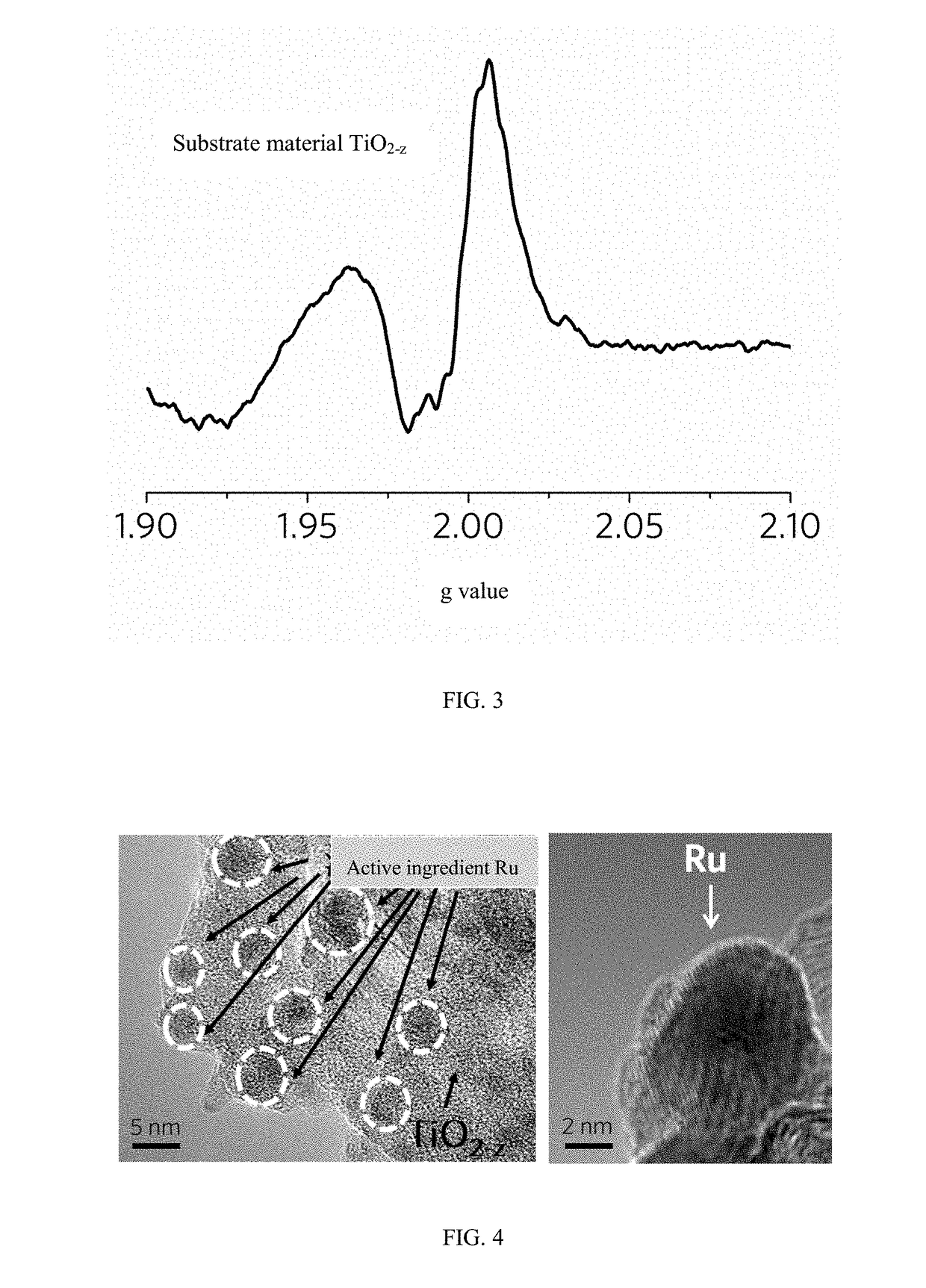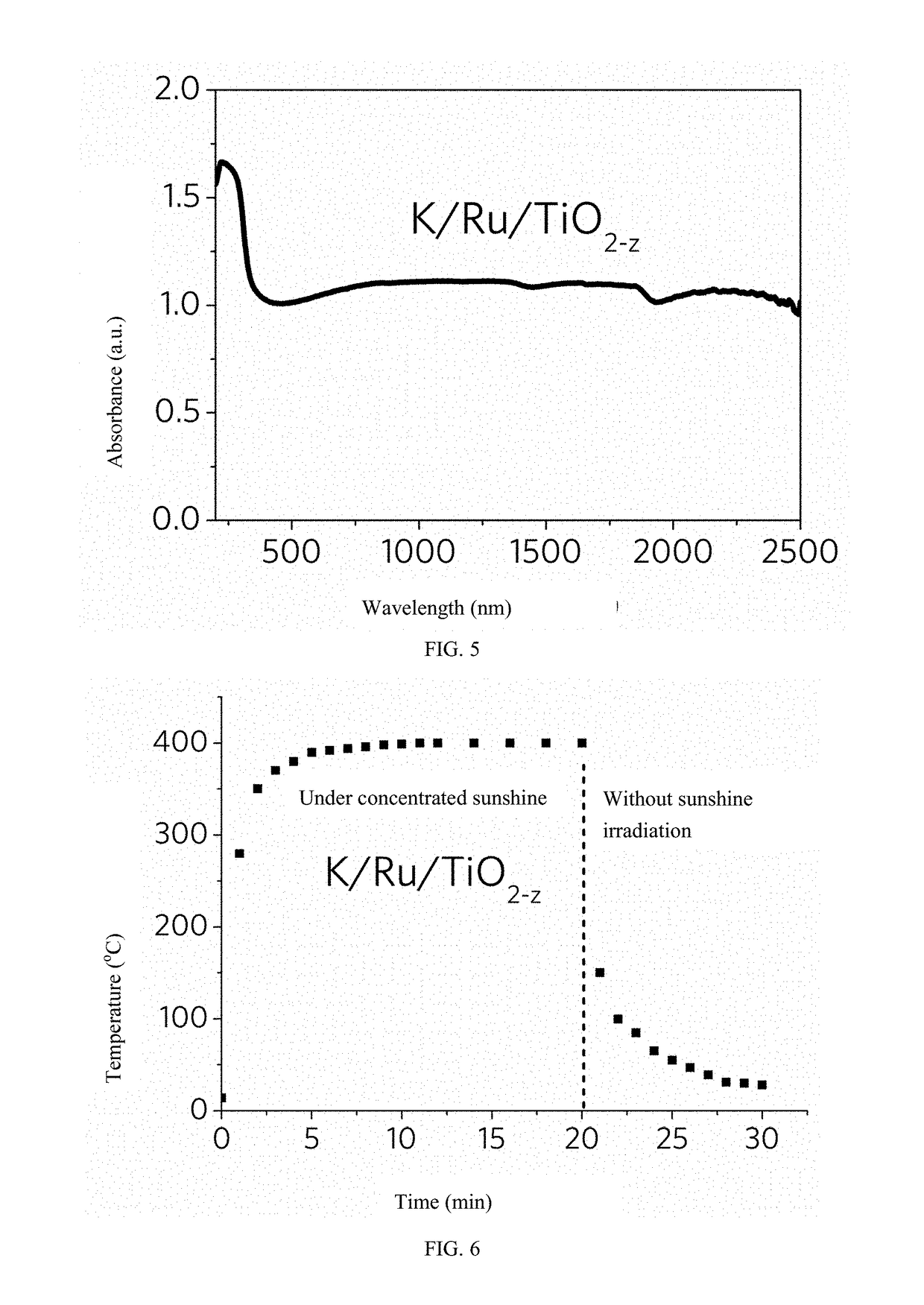Method for catalytic ammonia synthesis under concentrated solar energy and catalysts
a technology of solar energy and ammonia synthesis, which is applied in the direction of physical/chemical process catalysts, metal/metal-oxide/metal-hydroxide catalysts, bulk chemical production, etc., can solve the problems of large amount of fossil fuel consumption, greenhouse gas emission, energy conservation and emission reduction, etc., and achieve low cost, high efficiency, and high efficiency
- Summary
- Abstract
- Description
- Claims
- Application Information
AI Technical Summary
Benefits of technology
Problems solved by technology
Method used
Image
Examples
embodiment 1
[0048]The present embodiment shows the manufacturing of a catalyst with alkali metal or alkaline earth metal as promoter, and with Ru as active ingredient, which is loaded on black TiO2-z and the synthesizing of ammonia under a catalytic effect of concentrated sunshine.
[0049]Nano titanium oxide (1 g) and sodium borohydride (2 g) are ground fully and mixed together. The mixture is placed in a Muffle furnace, in which the temperature is raised to 370° C. at a speed of 10° C. / min. The crucible is taken out of the Muffle furnace at 370° C., and is put in an air environment at room temperature so that the temperature thereof drops rapidly. The solid product is placed in a beaker, and 100 ml deionized water is added to the beaker. Then, the beaker stays for 1 hour. The solid obtained therein is filtered and is washed with deionized water. The solid is dried in a vacuum drying oven at 100° C. for 4 hours, so that the carrier, i.e., black TiO2-z solid can be obtained. An X-Ray diffraction s...
embodiment 2
[0063]The present embodiment shows the manufacturing of a catalyst with alkali metal or alkaline earth metal as promoter, and with Fe as active ingredient, which is loaded on black TiO2-z, and the synthesizing of ammonia under a catalytic effect of concentrated sunshine.
[0064]Nano titanium oxide (1 g) and sodium borohydride (1.5 g) are ground fully and mixed together. The mixture is placed in a Muffle furnace, in which the temperature is raised to 410° C. at a speed of 10° C. / min. The crucible is taken out of the Muffle furnace at 410° C., and is put in an air environment at room temperature so that the temperature thereof drops rapidly. The solid product is placed in a beaker, and 100 ml deionized water is added to the beaker. Then, the beaker stays for 1 hour. The solid obtained therein is filtered and is washed with deionized water. The solid is dried in a vacuum drying oven at 100° C. for 4 hours, so that the carrier, i.e., black TiO2-z solid can be obtained. The TiO2-z is an am...
PUM
| Property | Measurement | Unit |
|---|---|---|
| surface temperature | aaaaa | aaaaa |
| pressure | aaaaa | aaaaa |
| temperature | aaaaa | aaaaa |
Abstract
Description
Claims
Application Information
 Login to View More
Login to View More - R&D
- Intellectual Property
- Life Sciences
- Materials
- Tech Scout
- Unparalleled Data Quality
- Higher Quality Content
- 60% Fewer Hallucinations
Browse by: Latest US Patents, China's latest patents, Technical Efficacy Thesaurus, Application Domain, Technology Topic, Popular Technical Reports.
© 2025 PatSnap. All rights reserved.Legal|Privacy policy|Modern Slavery Act Transparency Statement|Sitemap|About US| Contact US: help@patsnap.com



